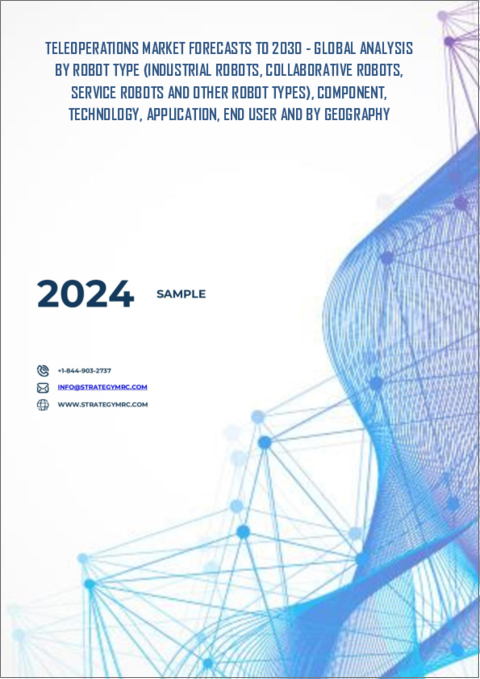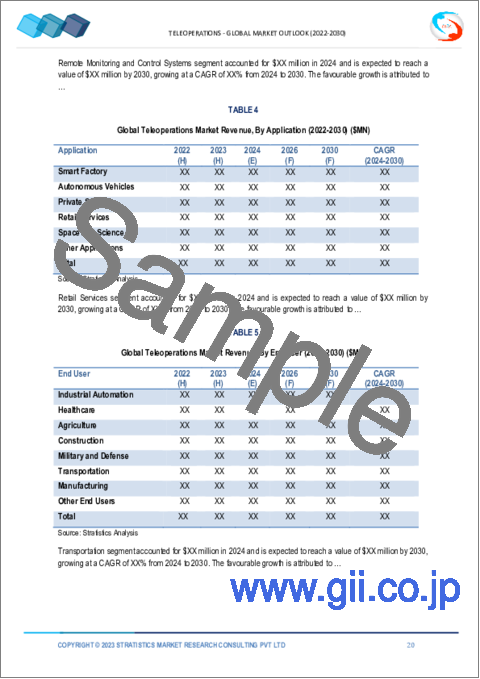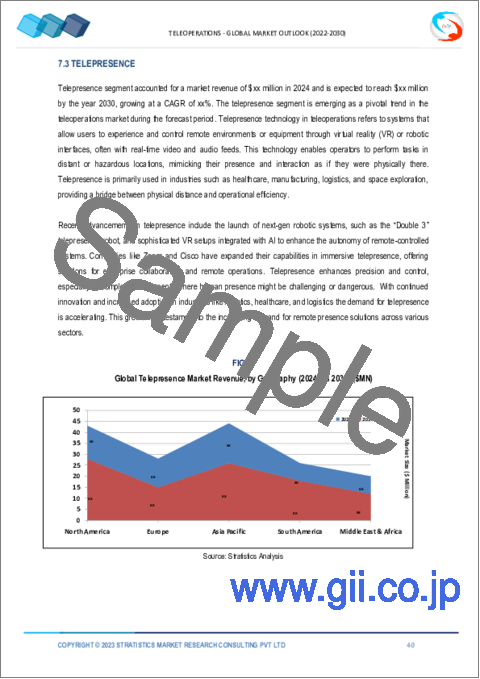|
|
市場調査レポート
商品コード
1494887
遠隔操作市場の2030年までの予測: ロボットタイプ別、コンポーネント別、技術別、用途別、エンドユーザー別、地域別の世界分析Teleoperations Market Forecasts to 2030 - Global Analysis By Robot Type (Industrial Robots, Collaborative Robots, Service Robots and Other Robot Types), Component, Technology, Application, End User and By Geography |
||||||
カスタマイズ可能
|
|||||||
| 遠隔操作市場の2030年までの予測: ロボットタイプ別、コンポーネント別、技術別、用途別、エンドユーザー別、地域別の世界分析 |
|
出版日: 2024年06月06日
発行: Stratistics Market Research Consulting
ページ情報: 英文 200+ Pages
納期: 2~3営業日
|
全表示
- 概要
- 図表
- 目次
Stratistics MRCによると、世界の遠隔操作市場は2024年に6億3,300万米ドルを占め、2030年までに26.3%のCAGRで成長し、25億6,940万米ドルに達すると予測されています。
通信操作とは、通信技術を使って装置、機械、システムを遠隔操作することです。これにより、オペレーターは離れた場所から機器を制御し、操作することができるようになり、危険な場所、アクセスしにくい場所、離れた場所での作業が可能になります。高度なセンサー、触覚フィードバック、リアルタイムのデータ伝送を利用することで、遠隔操作者は機械を正確かつ安全に操作することができます。遠隔操作の用途は、製造、ヘルスケア、宇宙開発、災害対応などの産業分野に及び、遠隔地での作業方法に革命をもたらしています。
アクメ・テレオペレーションズ社CEOのジョン・スミスは、「アクメ・テレオペレーションズ社によると、遠隔操作市場は今後数年間で大きく成長する見込みです。「遠隔操作機器とソフトウェア・ソリューションのリーディング・プロバイダーとして、当社は遠隔技術に対する需要の高まりに応え、この分野における技術革新を推進することをお約束します。
各業界でロボット工学の導入が増加
各業界でロボット工学の導入が進んでいることが、市場の成長を大きく後押ししています。企業は高度なロボット工学を遠隔操作機能に活用し、危険な環境での効率性と安全性を高めています。ヘルスケア、製造、物流などの分野では、遠隔手術、自動生産ライン、サプライチェーン管理などの作業でロボットの遠隔操作が役立っています。この動向に拍車をかけているのが、AI、機械学習、コネクティビティ技術の進歩で、ロボットシステムをより正確で信頼性の高い遠隔操作できるようになっています。
プライバシーとセキュリティへの懸念
遠隔操作市場におけるプライバシーとセキュリティの懸念は、潜在的なサイバー攻撃、データ漏洩、不正アクセスに関わるものです。遠隔操作中に送信される機密データは傍受や悪用されやすく、オペレーターとエンドユーザーの双方にリスクをもたらします。強固な暗号化、安全な通信チャネル、厳格な認証プロトコルを確保することは、情報を保護する上で極めて重要です。さらに、遠隔操作システムの信頼性と信頼性を維持するためには、プライバシー規制の遵守と脅威に対する継続的な監視が不可欠です。
通信技術の進歩
5G、エッジコンピューティング、AIといった通信技術の最近の進歩は、遠隔操作市場を大きく促進しています。これらの技術革新は、リアルタイムのデータ伝送を強化し、待ち時間を短縮し、遠隔操作システムの信頼性を向上させる。5Gの高速接続は、遠方からの機械や車両のシームレスな操作を可能にし、エッジコンピューティングは、より発生源に近いところでデータを処理することで、より迅速な応答を保証します。AIの統合は意思決定と業務効率を最適化し、遠隔操作の成長と能力をさらに促進します。
限られた感覚フィードバック
市場は、限られた感覚的フィードバックによる大きな課題に直面しています。オペレーターは触覚、聴覚、視覚的な手がかりの不足に悩まされることが多く、これが精度と効率の妨げとなっています。この制限は、外科手術、危険物マテリアルハンドリング、遠隔車両操作などの重要な分野に影響を及ぼしています。高度な触覚技術、改良された視覚システム、聴覚信号によって感覚フィードバックを強化することは、遠隔操作作業において制御を改善し、エラーを減らし、安全を確保するために不可欠です。この問題に対処することは、市場の成長と効果にとって不可欠です。
COVID-19の影響:
COVID-19の流行は遠隔操作市場の成長を著しく加速させました。封鎖や社会との距離を置く措置が広まる中、企業や産業界は生産性を維持し安全を確保するために遠隔操作技術を採用する傾向が強まった。ヘルスケア、ロジスティクス、製造業では、リスクの高いエリアでの人間の存在を最小限に抑える必要性から、遠隔操作システムの需要が急増しました。その結果、パンデミックは技術の進歩を促進し、様々な分野での遠隔操作の採用を拡大し、パンデミック後の世界における遠隔操作の重要性を確固たるものにしました。
協働ロボットは予測期間中最大となる見込み
協働ロボットは、予測期間中に最大となる見込みです。これらのロボットは人間のそばで働き、人間の意思決定とロボットの精度を組み合わせる。ヘルスケア、製造、防衛などの産業において、コボットは遠隔手術から危険な環境でのハンドリングまで幅広い作業を容易にします。大がかりな安全バリアなしに人間のすぐそばで操作できるコボットは、効率の向上、リスクの低減、遠隔操作可能なアプリケーションの範囲の拡大において貴重な存在となっています。
予測期間中、スマートファクトリー分野のCAGRが最も高くなると予想されます。
スマート工場セグメントは、予測期間中に最も高いCAGRが見込まれます。これらの工場は、機械や生産ラインの遠隔監視と制御を可能にすることで、業務効率を高め、人的介入を減らし、安全性を向上させる。リアルタイムのデータと分析を活用することで、スマート工場は生産ワークフローを最適化し、メンテナンスの必要性を予測し、ダウンタイムを最小化します。この技術革新は、製造業に大きな進歩をもたらし、より大きな柔軟性と拡張性を促進しています。
最大のシェアを占める地域
北米は、ロボット工学、AI、通信インフラの進歩により、予測期間中最大の市場シェアを占めると予測されます。ヘルスケア、製造業、運輸業などの業界で遠隔操作ソリューションの需要が急増し、同地域では投資と導入が増加しています。遠隔操作は、遠隔手術から無人車両の操作まで幅広い作業を容易にし、効率性、安全性、柔軟性を提供します。
CAGRが最も高い地域:
予測期間中、アジア太平洋地域が最も高いCAGRを維持すると予測されています。同地域では、ロボット工学、人工知能(AI)、通信などの技術が急速に進歩し、より高度な遠隔操作システムが可能となっています。同地域の多くの産業は、効率改善とコスト削減のために自動化を導入しています。遠隔操作は、自動化システムの遠隔制御と監視を可能にする上で重要な役割を果たしています。
無料カスタマイズサービス:
本レポートをご購読のお客様には、以下の無料カスタマイズオプションのいずれかをご利用いただけます:
- 企業プロファイル
- 追加市場企業の包括的プロファイリング(3社まで)
- 主要企業のSWOT分析(3社まで)
- 地域セグメンテーション
- 顧客の関心に応じた主要国の市場推計・予測・CAGR(注:フィージビリティチェックによる)
- 競合ベンチマーキング
- 製品ポートフォリオ、地理的プレゼンス、戦略的提携に基づく主要企業のベンチマーキング
目次
第1章 エグゼクティブサマリー
第2章 序文
- 概要
- ステークホルダー
- 調査範囲
- 調査手法
- データマイニング
- データ分析
- データ検証
- 調査アプローチ
- 調査情報源
- 1次調査情報源
- 2次調査情報源
- 前提条件
第3章 市場動向分析
- 促進要因
- 抑制要因
- 機会
- 脅威
- 技術分析
- 用途分析
- エンドユーザー分析
- 新興市場
- COVID-19の影響
第4章 ポーターのファイブフォース分析
- 供給企業の交渉力
- 買い手の交渉力
- 代替品の脅威
- 新規参入業者の脅威
- 競争企業間の敵対関係
第5章 世界の遠隔操作市場:ロボットタイプ別
- 産業用ロボット
- 協働ロボット
- サービスロボット
- その他のロボットタイプ
第6章 世界のテレオペレーション市場:コンポーネント別
- ソフトウェア
- 制御ソフトウェア
- ユーザーインターフェース
- 遠隔モニタリング
- ハードウェア
- 通信機器
- センサー
- コントローラー
- ロボット
- フィードバックデバイス
- サービス
- システムデザイン
- 統合
- トレーニング
第7章 世界のテレオペレーション市場:技術別
- テレロボティクス
- テレプレゼンス
- 遠隔操作
- 遠隔監視・制御システム
- その他の技術
第8章 世界のテレオペレーション市場:用途別
- スマートファクトリー
- 自動運転車
- 民間警備
- 小売サービス
- 宇宙と科学
- その他の用途
第9章 世界のテレオペレーション市場:エンドユーザー別
- 産業自動化
- ヘルスケア
- 農業
- 建設
- 軍事と防衛
- 交通機関
- 製造業
- その他のエンドユーザー
第10章 世界のテレオペレーション市場:地域別
- 北米
- 米国
- カナダ
- メキシコ
- 欧州
- ドイツ
- 英国
- イタリア
- フランス
- スペイン
- その他欧州
- アジア太平洋
- 日本
- 中国
- インド
- オーストラリア
- ニュージーランド
- 韓国
- その他アジア太平洋
- 南米
- アルゼンチン
- ブラジル
- チリ
- その他南米
- 中東・アフリカ
- サウジアラビア
- アラブ首長国連邦
- カタール
- 南アフリカ
- その他中東・アフリカ
第11章 主な発展
- 契約、パートナーシップ、コラボレーション、合弁事業
- 買収と合併
- 新製品発売
- 事業拡大
- その他の主要戦略
第12章 企業プロファイリング
- ABB Ltd
- Honda Motors
- Quantum Signal LLC
- Bluefin Robotics Corporation
- Phantom Auto
- Cognicept
- Amazon Robotics
- Nokia
- Samsung
- Asus
- Intel
- Yaskawa Electric Corporation
- Ericsson
- Toyota Material Handling
- Mitsubishi Electric Corporation
- Blue Ocean Robotics
- Siemens AG
List of Tables
- Table 1 Global Teleoperations Market Outlook, By Region (2022-2030) ($MN)
- Table 2 Global Teleoperations Market Outlook, By Robot Type (2022-2030) ($MN)
- Table 3 Global Teleoperations Market Outlook, By Industrial Robots (2022-2030) ($MN)
- Table 4 Global Teleoperations Market Outlook, By Collaborative Robots (2022-2030) ($MN)
- Table 5 Global Teleoperations Market Outlook, By Service Robots (2022-2030) ($MN)
- Table 6 Global Teleoperations Market Outlook, By Other Robot Types (2022-2030) ($MN)
- Table 7 Global Teleoperations Market Outlook, By Component (2022-2030) ($MN)
- Table 8 Global Teleoperations Market Outlook, By Software (2022-2030) ($MN)
- Table 9 Global Teleoperations Market Outlook, By Control Software (2022-2030) ($MN)
- Table 10 Global Teleoperations Market Outlook, By User Interfaces (2022-2030) ($MN)
- Table 11 Global Teleoperations Market Outlook, By Remote Monitoring (2022-2030) ($MN)
- Table 12 Global Teleoperations Market Outlook, By Hardware (2022-2030) ($MN)
- Table 13 Global Teleoperations Market Outlook, By Communication Devices (2022-2030) ($MN)
- Table 14 Global Teleoperations Market Outlook, By Sensors (2022-2030) ($MN)
- Table 15 Global Teleoperations Market Outlook, By Controllers (2022-2030) ($MN)
- Table 16 Global Teleoperations Market Outlook, By Robots (2022-2030) ($MN)
- Table 17 Global Teleoperations Market Outlook, By Feedback Devices (2022-2030) ($MN)
- Table 18 Global Teleoperations Market Outlook, By Services (2022-2030) ($MN)
- Table 19 Global Teleoperations Market Outlook, By System Design (2022-2030) ($MN)
- Table 20 Global Teleoperations Market Outlook, By Integration (2022-2030) ($MN)
- Table 21 Global Teleoperations Market Outlook, By Training (2022-2030) ($MN)
- Table 22 Global Teleoperations Market Outlook, By Technology (2022-2030) ($MN)
- Table 23 Global Teleoperations Market Outlook, By Telerobotics (2022-2030) ($MN)
- Table 24 Global Teleoperations Market Outlook, By Telepresence (2022-2030) ($MN)
- Table 25 Global Teleoperations Market Outlook, By Telemanipulation (2022-2030) ($MN)
- Table 26 Global Teleoperations Market Outlook, By Remote Monitoring and Control Systems (2022-2030) ($MN)
- Table 27 Global Teleoperations Market Outlook, By Other Technologies (2022-2030) ($MN)
- Table 28 Global Teleoperations Market Outlook, By Application (2022-2030) ($MN)
- Table 29 Global Teleoperations Market Outlook, By Smart Factory (2022-2030) ($MN)
- Table 30 Global Teleoperations Market Outlook, By Autonomous Vehicles (2022-2030) ($MN)
- Table 31 Global Teleoperations Market Outlook, By Private Security (2022-2030) ($MN)
- Table 32 Global Teleoperations Market Outlook, By Retail Services (2022-2030) ($MN)
- Table 33 Global Teleoperations Market Outlook, By Space and Science (2022-2030) ($MN)
- Table 34 Global Teleoperations Market Outlook, By Other Applications (2022-2030) ($MN)
- Table 35 Global Teleoperations Market Outlook, By End User (2022-2030) ($MN)
- Table 36 Global Teleoperations Market Outlook, By Industrial Automation (2022-2030) ($MN)
- Table 37 Global Teleoperations Market Outlook, By Healthcare (2022-2030) ($MN)
- Table 38 Global Teleoperations Market Outlook, By Agriculture (2022-2030) ($MN)
- Table 39 Global Teleoperations Market Outlook, By Construction (2022-2030) ($MN)
- Table 40 Global Teleoperations Market Outlook, By Military and Defense (2022-2030) ($MN)
- Table 41 Global Teleoperations Market Outlook, By Transportation (2022-2030) ($MN)
- Table 42 Global Teleoperations Market Outlook, By Manufacturing (2022-2030) ($MN)
- Table 43 Global Teleoperations Market Outlook, By Other End Users (2022-2030) ($MN)
Note: Tables for North America, Europe, APAC, South America, and Middle East & Africa Regions are also represented in the same manner as above.
According to Stratistics MRC, the Global Teleoperations Market is accounted for $633.0 million in 2024 and is expected to reach $2,569.4 million by 2030 growing at a CAGR of 26.3% during the forecast period. Teleoperations is the remote operation of devices, machinery, or systems using telecommunications technology. This allows operators to control and interact with equipment from a distance, enabling tasks to be performed in hazardous, inaccessible, or distant locations. Through the use of advanced sensors, haptic feedback, and real-time data transmission, teleoperators can manipulate machinery with precision and safety. The applications of teleoperations span across industries such as manufacturing, healthcare, space exploration, and disaster response, revolutionizing the way tasks are executed remotely.
According to Acme Teleoperations, the teleoperations market is expected to grow significantly in the coming years," said John Smith, CEO of Acme Teleoperations. "As a leading provider of teleoperated equipment and software solutions, we're committed to meeting the increasing demand for remote technologies and driving innovation in this space.
Market Dynamics:
Driver:
Increased adoption of robotics across industries
The increased adoption of robotics across industries is significantly driving growth in the market. Companies are leveraging advanced robotics for remote operation capabilities, enhancing efficiency and safety in hazardous environments. Sectors like healthcare, manufacturing, and logistics benefit from robotic teleoperation for tasks such as remote surgeries, automated production lines, and supply chain management. This trend is fueled by advancements in AI, machine learning, and connectivity technologies, enabling more precise and reliable remote control of robotic systems.
Restraint:
Privacy and security concerns
Privacy and security concerns in the teleoperations market revolve around potential cyberattacks, data breaches, and unauthorized access. Sensitive data transmitted during remote operations is vulnerable to interception and misuse, posing risks to both operators and end-users. Ensuring robust encryption, secure communication channels, and stringent authentication protocols is critical to safeguarding information. Additionally, compliance with privacy regulations and continuous monitoring for threats are essential to maintain trust and reliability in teleoperated systems.
Opportunity:
Advancements in communication technologies
Recent advancements in communication technologies, such as 5G, edge computing, and AI, have significantly propelled the teleoperations market. These innovations enhance real-time data transmission, reduce latency, and improve the reliability of remote control systems. 5G's high-speed connectivity enables seamless operation of machinery and vehicles from afar, while edge computing processes data closer to the source, ensuring faster responses. AI integration optimizes decision-making and operational efficiency, further driving the growth and capabilities of teleoperations.
Threat:
Limited sensory feedback
The market faces a significant challenge due to limited sensory feedback. Operators often struggle with a lack of tactile, auditory, and visual cues, which hampers precision and efficiency. This limitation affects critical sectors like surgery, hazardous material handling, and remote vehicle operation. Enhancing sensory feedback through advanced haptic technology, improved visual systems, and auditory signals is essential for improving control, reducing errors, and ensuring safety in teleoperation tasks. Addressing this issue is vital for the market's growth and effectiveness.
Covid-19 Impact:
The COVID-19 pandemic significantly accelerated the growth of the teleoperations market. With widespread lockdowns and social distancing measures, businesses and industries increasingly adopted remote operation technologies to maintain productivity and ensure safety. The demand surged for teleoperated systems in healthcare, logistics, and manufacturing, driven by the need to minimize human presence in high-risk areas. Consequently, the pandemic catalyzed technological advancements and expanded the adoption of teleoperations across various sectors, solidifying its importance in the post-pandemic world.
The collaborative robots segment is expected to be the largest during the forecast period
The collaborative robots is expected to be the largest during the forecast period. These robots work alongside humans, combining human decision-making with robotic accuracy. In industries such as healthcare, manufacturing, and defense, cobots facilitate tasks ranging from remote surgery to hazardous environment handling. Their ability to operate in close proximity to humans without extensive safety barriers makes them invaluable in improving efficiency, reducing risk, and expanding the scope of teleoperable applications.
The smart factory segment is expected to have the highest CAGR during the forecast period
The smart factory segment is expected to have the highest CAGR during the forecast period. These factories enhance operational efficiency, reduce human intervention, and improve safety by allowing remote monitoring and control of machinery and production lines. By leveraging real-time data and analytics, smart factories optimize production workflows, predict maintenance needs, and minimize downtime. This innovation is driving significant advancements in the manufacturing industry, promoting greater flexibility and scalability.
Region with largest share:
North America is projected to hold the largest market share during the forecast period driven by advancements in robotics, AI, and telecommunications infrastructure. With a surge in demand for remote operation solutions across industries such as healthcare, manufacturing, and transportation, the region is witnessing increased investment and adoption. Teleoperations facilitate tasks ranging from remote surgeries to unmanned vehicle operations, offering efficiency, safety, and flexibility.
Region with highest CAGR:
Asia Pacific is projected to hold the highest CAGR over the forecast period. The region has seen rapid advancements in technologies such as robotics, artificial intelligence (AI), and telecommunications, enabling more sophisticated teleoperation systems. Many industries in the region are adopting automation to improve efficiency and reduce costs. Teleoperation plays a crucial role in enabling remote control and monitoring of automated systems.
Key players in the market
Some of the key players in Teleoperations market include ABB Ltd, Honda Motors, Quantum Signal LLC, Bluefin Robotics Corporation, Phantom Auto, Cognicept, Amazon Robotics, Nokia, Google, Samsung, Asus, Intel, Yaskawa Electric Corporation, Ericsson, Toyota Material Handling, Mitsubishi Electric Corporation, Blue Ocean Robotics and Siemens AG.
Key Developments:
In March 2023, Honda revealed New Prototype Autonomous Work Vehicle at CONEXPO 2023. New capabilities include more pallet capacity, payload, and enhanced obstacle detection. Honda invites potential business partners and companies interested in field testing AWV to Honda's booth at CONEXPO 2023.
In March 2023, Honda Motor Company's President and CEO, Toshihiro Mibe, announced the company's focus on autonomous driving and generative AI technologies at the Japan Mobility Show. Honda plans to launch a driverless ride-hailing service in Japan in 2026 using the autonomous vehicle Cruise Origin.
Robot Types Covered:
- Industrial Robots
- Collaborative Robots
- Service Robots
- Other Robot Types
Components Covered:
- Software
- Hardware
- Services
Technologies Covered:
- Telerobotics
- Telepresence
- Telemanipulation
- Remote Monitoring and Control Systems
- Other Technologies
Applications Covered:
- Smart Factory
- Autonomous Vehicles
- Private Security
- Retail Services
- Space and Science
- Other Applications
End Users Covered:
- Industrial Automation
- Healthcare
- Agriculture
- Construction
- Military and Defense
- Transportation
- Manufacturing
- Other End Users
Regions Covered:
- North America
- US
- Canada
- Mexico
- Europe
- Germany
- UK
- Italy
- France
- Spain
- Rest of Europe
- Asia Pacific
- Japan
- China
- India
- Australia
- New Zealand
- South Korea
- Rest of Asia Pacific
- South America
- Argentina
- Brazil
- Chile
- Rest of South America
- Middle East & Africa
- Saudi Arabia
- UAE
- Qatar
- South Africa
- Rest of Middle East & Africa
What our report offers:
- Market share assessments for the regional and country-level segments
- Strategic recommendations for the new entrants
- Covers Market data for the years 2022, 2023, 2024, 2026, and 2030
- Market Trends (Drivers, Constraints, Opportunities, Threats, Challenges, Investment Opportunities, and recommendations)
- Strategic recommendations in key business segments based on the market estimations
- Competitive landscaping mapping the key common trends
- Company profiling with detailed strategies, financials, and recent developments
- Supply chain trends mapping the latest technological advancements
Free Customization Offerings:
All the customers of this report will be entitled to receive one of the following free customization options:
- Company Profiling
- Comprehensive profiling of additional market players (up to 3)
- SWOT Analysis of key players (up to 3)
- Regional Segmentation
- Market estimations, Forecasts and CAGR of any prominent country as per the client's interest (Note: Depends on feasibility check)
- Competitive Benchmarking
- Benchmarking of key players based on product portfolio, geographical presence, and strategic alliances
Table of Contents
1 Executive Summary
2 Preface
- 2.1 Abstract
- 2.2 Stake Holders
- 2.3 Research Scope
- 2.4 Research Methodology
- 2.4.1 Data Mining
- 2.4.2 Data Analysis
- 2.4.3 Data Validation
- 2.4.4 Research Approach
- 2.5 Research Sources
- 2.5.1 Primary Research Sources
- 2.5.2 Secondary Research Sources
- 2.5.3 Assumptions
3 Market Trend Analysis
- 3.1 Introduction
- 3.2 Drivers
- 3.3 Restraints
- 3.4 Opportunities
- 3.5 Threats
- 3.6 Technology Analysis
- 3.7 Application Analysis
- 3.8 End User Analysis
- 3.9 Emerging Markets
- 3.10 Impact of Covid-19
4 Porters Five Force Analysis
- 4.1 Bargaining power of suppliers
- 4.2 Bargaining power of buyers
- 4.3 Threat of substitutes
- 4.4 Threat of new entrants
- 4.5 Competitive rivalry
5 Global Teleoperations Market, By Robot Type
- 5.1 Introduction
- 5.2 Industrial Robots
- 5.3 Collaborative Robots
- 5.4 Service Robots
- 5.5 Other Robot Types
6 Global Teleoperations Market, By Component
- 6.1 Introduction
- 6.2 Software
- 6.2.1 Control Software
- 6.2.2 User Interfaces
- 6.2.3 Remote Monitoring
- 6.3 Hardware
- 6.3.1 Communication Devices
- 6.3.2 Sensors
- 6.3.3 Controllers
- 6.3.4 Robots
- 6.3.5 Feedback Devices
- 6.4 Services
- 6.4.1 System Design
- 6.4.2 Integration
- 6.4.3 Training
7 Global Teleoperations Market, By Technology
- 7.1 Introduction
- 7.2 Telerobotics
- 7.3 Telepresence
- 7.4 Telemanipulation
- 7.5 Remote Monitoring and Control Systems
- 7.6 Other Technologies
8 Global Teleoperations Market, By Application
- 8.1 Introduction
- 8.2 Smart Factory
- 8.3 Autonomous Vehicles
- 8.4 Private Security
- 8.5 Retail Services
- 8.6 Space and Science
- 8.7 Other Applications
9 Global Teleoperations Market, By End User
- 9.1 Introduction
- 9.2 Industrial Automation
- 9.3 Healthcare
- 9.4 Agriculture
- 9.5 Construction
- 9.6 Military and Defense
- 9.7 Transportation
- 9.8 Manufacturing
- 9.9 Other End Users
10 Global Teleoperations Market, By Geography
- 10.1 Introduction
- 10.2 North America
- 10.2.1 US
- 10.2.2 Canada
- 10.2.3 Mexico
- 10.3 Europe
- 10.3.1 Germany
- 10.3.2 UK
- 10.3.3 Italy
- 10.3.4 France
- 10.3.5 Spain
- 10.3.6 Rest of Europe
- 10.4 Asia Pacific
- 10.4.1 Japan
- 10.4.2 China
- 10.4.3 India
- 10.4.4 Australia
- 10.4.5 New Zealand
- 10.4.6 South Korea
- 10.4.7 Rest of Asia Pacific
- 10.5 South America
- 10.5.1 Argentina
- 10.5.2 Brazil
- 10.5.3 Chile
- 10.5.4 Rest of South America
- 10.6 Middle East & Africa
- 10.6.1 Saudi Arabia
- 10.6.2 UAE
- 10.6.3 Qatar
- 10.6.4 South Africa
- 10.6.5 Rest of Middle East & Africa
11 Key Developments
- 11.1 Agreements, Partnerships, Collaborations and Joint Ventures
- 11.2 Acquisitions & Mergers
- 11.3 New Product Launch
- 11.4 Expansions
- 11.5 Other Key Strategies
12 Company Profiling
- 12.1 ABB Ltd
- 12.2 Honda Motors
- 12.3 Quantum Signal LLC
- 12.4 Bluefin Robotics Corporation
- 12.5 Phantom Auto
- 12.6 Cognicept
- 12.7 Amazon Robotics
- 12.8 Nokia
- 12.9 Google
- 12.10 Samsung
- 12.11 Asus
- 12.12 Intel
- 12.13 Yaskawa Electric Corporation
- 12.14 Ericsson
- 12.15 Toyota Material Handling
- 12.16 Mitsubishi Electric Corporation
- 12.17 Blue Ocean Robotics
- 12.18 Siemens AG





